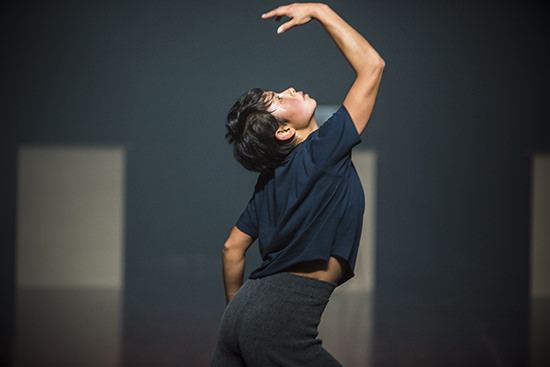Next Wave Festival: Many ways into “energized tranquility”
Alison Finn: Admission Into The Everyday Sublime

Lilian Steiner, Admission Into The Everyday Sublime, Next Wave 2016
photo Gregory Lorenzutti
Lilian Steiner, Admission Into The Everyday Sublime, Next Wave 2016
When the doors open to the North Melbourne Town Hall for Admission Into The Everyday Sublime, we walk into a thick haze, there’s a heavy drone. Yes!, I think, skirting around the people wrestling, we’ve zoned into some weird medieval bash or dusty Olympic quadrangle. We haven’t, but the fact that this scene is already underway is a clue to the nature of director and choreographer Lilian Steiner’s work. It will evolve into an installation, constituted by light, sound and space as much as by dance.
There are four performers (including Steiner) soberly costumed in navy T-shirts and loose knit pants. A man and woman grapple, slapping their weight calmly into each other; it looks like a kind of sport or a martial art. The top of his head slumps into her upper back and he rubs it blindly up and down. Another man jogs through a large, precise semi-circle with the other female dancer (Briarna Longville) at its centre like the fixed arm of a compass, and when she shifts, their connection dissolves; he drops away. Circles (and semi-circles and arcs) are already everywhere: they’ll be a major motif in both the movement and spatial design.
They hold and shove each other in pairs; a man jumps onto Steiner and she clutches him for a while, straining to support his weight. We’re in a realm where the body’s latent energy can be corralled, drawn out, exchanged by touch or ritual. Longville’s hands hover a hand’s width from her partner’s sternum, then execute a sudden slap. Hands are remarkable agents in this work that can: perform benediction (index and pointer fingers raised), or hold a rock, now stretch an archer’s bow, and execute myriad flicking, stirring, swatting, patting, jabbing motions. Time stretches while the two men become icon-like, hieroglyphs flooded by an intense red light, their chins fixedly inclined. They rotate very slowly with one palm up (a rock fills it) and the other down.
In periods where the movement is radically slowed or repeated, we might be invited into a meditative self-consciousness. The traverse seating makes visible the range of audience responses to the duration of this sequence, which seems to include both transfixion and fidgeting (two people leave). Maybe it depends on your appetite for this ‘nothing-happens-ness.’ Though compared to some more extreme examples of durational performance across noise music, visual art and dance, where very slight shifts in sensation become tectonic, there were much more stimuli here.
Steiner and Longville return to pony around the semi-circular lines established in the work’s opening, every now and then bursting into a stag leap. When they dance it’s fluid and expansive, ribcages shift and spines roll. They’re visibly sweating and we realise that these women (presumably because they’re the two trained dancers of the four) have performed most of the labour, at times literally bearing the weight of the men. Nevertheless, the choreography allows for a variety of restful states, the performers frequently appear drowsy or slumped, as if there might be only a thin membrane between activity and sleep. Longville picks up a rock and moves it near to our feet, then collapses. The two resume dancing but they’re scribbling now, arms scoop and fling, they shake, wriggle, shoulders dribble jerkily down, elbows shimmy. This is very much about the joints—hips, knees, elbows, wrists all hinge. Patterns are mercilessly interrupted, a pose no sooner assumed than abandoned.
By this time the men have receded, sitting on plinths in the shadows at one end of the space to generate the layers of drones, whirs and growls making up the sound production. When the women assume similar positions, the sound- and light-scape takes over for another long period. We stare, necks craned, as Ash Keating’s enormous artwork is gradually revealed. The sublime, with its potential for awe and veneration and its aesthetic complexity, is an ambitious concept to invoke. Lilian Steiner has said that she wanted to lure the audience to “states of energised tranquility.” Perhaps this is what a reconciliation of the everyday and the sublime would feel like? Keating’s final image could be many things—a hole, cigarette burn or navel, mere circle, ‘the source,’ or God—to me it looked like the interior of a chapel dome with its tiny aperture, viewed from below. Higher up, the circles of the Town Hall’s ceiling roses appear, and the rows of circular lights in their rigs; another neat conjunction of the everyday and the potentially sublime.
–
Next Wave Festival 2016: Admission Into The Everyday Sublime, choreographer Lilian Steiner, performers Atticus Bastow, Briarna Longville, Jonathon Nokes, Lilian Steiner, sound Atticus Bastow, Jonathon Nokes, lighting Matthew Adey, costumes Shio Otani, commissioned artwork Ash Keating; Arts House, North Melbourne, 18-22 May
Alison Finn works in criminal law in Melbourne, with particular interests in the law and the philosophy of human dignity, privacy, surveillance and ‘big data.’ She also writes creatively in various forms and continues a contemporary dance practice.
This review was written in the DanceWrite dance reviewing workshop. Read more reviews here.
DanceWrite was conducted by RealTime editors Keith Gallasch and Virginia Baxter with mentors Andrew Fuhrmann and Jana Perkovic. The workshop was an initiative of Hannah Matthews as part of her Australia Council-funded Sharing Space program and was presented in collaboration with Next Wave and RealTime.
RealTime issue #132 April-May 2016






